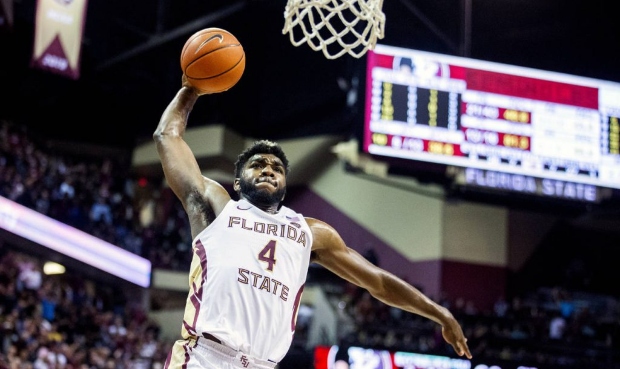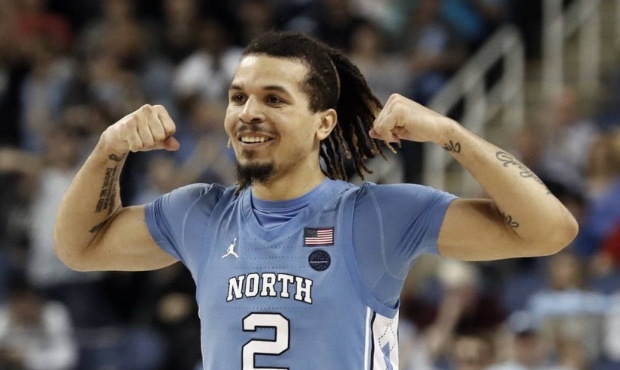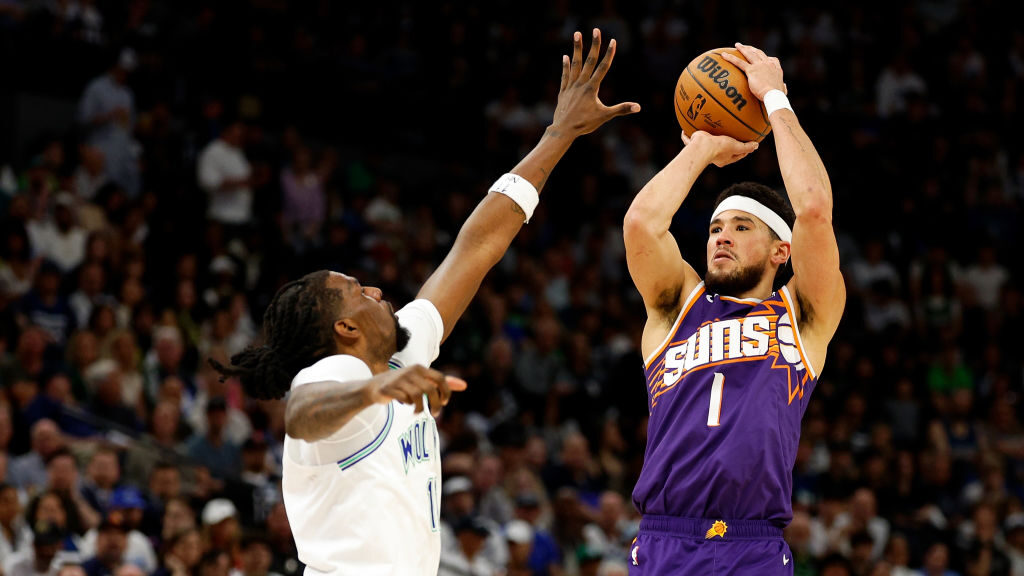Empire of the Suns NBA Draft Big Board, Pt. 4: The darkhorse at PG
Jun 17, 2020, 10:19 AM

(AP Photo/Mark Humphrey, File)
(AP Photo/Mark Humphrey, File)
It’s that time of year again! Well, at least we assume it is.
The 2020 NBA Draft is coming at some point. It’s reportedly scheduled for Oct. 15. We’ll see.
The Phoenix Suns are currently slotted 10th in the reverse standings, which will hold if neither they nor the Eastern Conference’s Washington Wizards make the playoffs after an eight-game regular season.
Let’s take our time waiting to find out their draft slot by getting familiar with the top prospects.
With a third guard and power forward at the top of Phoenix’s shopping list this offseason, it’s actually quite a good class for James Jones and company to comb through.
Through three parts, our fourth includes a point guard who has a decent chance of being available when the Suns pick.
All statistics via Hoop-Math and Sports-Reference
Tier 3 continued
8. Kira Lewis Jr., PG, Alabama, 19 years old
Lewis has some of the highest upside in this draft, and it’s not easy to see unless you take a close look.
He essentially has the first, occasionally second and sometimes even third steps done of a multi-step process developing specific skills. His point guard reads, passing ability, scoring acumen, shooting off the dribble and defense are all there to a certain point.
If he gets on an above-average improvement trajectory in the NBA, he will be a great all-around point guard.
Lewis is one of those guys that gets faster with the ball in his hands, and luckily for NBA teams, Lewis clearly dedicated himself to having some go-to moves with shiftiness to his handle too.
He took 42.5% of his shots at the rim, a very high number for your typical lottery point guard prospect. That’s a higher percentage than fellow first-round prospects Nico Mannion (20.1%) and Cole Anthony (20.0%) combined. It’s a much higher mark than Tyrese Maxey (31.1%), Anthony Edwards (26.5%) and Tyrese Haliburton (24.6%).
Lewis’ volume at the rim compares to Ja Morant (53.1%), Shai Gilgeous-Alexander (44.3%) and De’Aaron Fox (48.1%), three recent guard prospects who have begun to blossom in the NBA.
As an added bonus on the volume, Lewis shot 57.9% around the basket. He just blows by dudes, with a good feel for finishing.
Kira Lewis just ended Isaac Okoro's basketball career. I'm sorry. But there is no coming back from this. pic.twitter.com/4T0vkHwrXW
— Aaron Torres (@Aaron_Torres) January 16, 2020
Weeeeee!
Nice effing move Kira Lewis 😳 pic.twitter.com/zKgJujP3IJ
— Simon Rath (@HawksDraftNerd) March 4, 2020
Lewis goes a step further by being capable of creating his own shot beyond line-drive finishes at the basket, pulling up off the dribble and mostly taking the right shots. The mid-range jumper, while still a work in progress at 34.8% on 2.9 attempts a game, looks good on pull-ups.
Here’s one from three-point range, where Lewis shot over 35% on over four attempts a game in back-to-back seasons.
Really impressive stuff here from Kira Lewis Jr. Teams have to respect his quickness. He fakes the drive and is able to stop on a dime for a pull-up 3PA (Really smooth form too). pic.twitter.com/R6EQSiPvmO
— Richie (@RichieRandall) April 17, 2020
Only 52.7% of his attempts from deep this past season were assisted, meaning a whole lot of these were not catch-and-shoot. You should be impressed by 36.6%.
And when Lewis is playmaking, he’s making pocket and swing passes frequently enough that he’s grown into manipulating defenses.
Part 1 – Kira Lewis has a lot of very impressive passes out of the PnR, even if the majority are simple passes to the perimeter because of his rim pressure.
He's patient vs doubles/hedges. Makes crosscourt skip passes w/ power & accuracy. Leads bigs w/ pocket passes, and more pic.twitter.com/33ayYxUYa5
— Zach Milner (@ZachMilner13) April 17, 2020
Defensively, he can hound guys on the ball and use that agility there to be a pest. He cares off the ball as well. While it’s more toolsy and effort than execution, that’s a good base to work from.
This is the point where we get back to reinforce the opening. All of Lewis’ skills are somewhere from a C- to a B+ grade.
He’s obviously going to need to get better year to year, but it’s difficult to find well-rounded prospects in this class, and he is one with the improvement he already showed from his freshman to sophomore season.
Teams that trust their player development should have him rated much higher than the 15-30 range, where you will mostly find Lewis.
7. James Wiseman, C, Memphis, 19 years old
A couple of things to understand about this class if you haven’t already arrived here:
It lacks high-level builds when we’re piling together, height, wingspan, athleticism, etc. The top-3 are almost there by default because of their upside. LaMelo Ball’s playmaking is the only premium skill in this class, and maybe Anthony Edwards’ scoring if you’re being nice. That’s it.
So when James Wiseman is there, all 7-foot-1 with a 7-foot-6 wingspan and awesome mobility of him, he’s gonna go top-3 in this class. And that’s operating in a world where he doesn’t get private workouts, which if he does, I’d put my house on him going number one.
Check out the speed in the open floor from the first clip and length for the rebound in the second.
The biggest conflict here is that Wiseman barely played at Memphis (three games!) before dipping on outta there. The limited tape resembles someone who loves other parts of their game much, much, much, much more than what they should focus on being good at.
Let me know if the description here reminds you of someone familiar!
Bad Wiseman clip:
He lacks phisicality especially when he gets post touches, often settling for jumpers. This clip is good to undestand that, has a good post position and could easily bump his opponent for an easy basket, instead he goes for a smooth jumper.. pic.twitter.com/WRn9dgmCv7— Filippo 📣 👻 (@BarresiFilippo4) March 28, 2020
Wiseman likes his jumper. A lot. Well, that’s at least what the high school tape shows us, which is what we have to rely on here. I will not apologize for being unwilling to put much weight in a trouncing over South Carolina State.
So, that’s challenging from an evaluation standpoint. Remember how stupid you were as a high school senior? Pretty dumb, right? Well, at least I was a moron. You might have been better than me.
Wiseman is also obviously a center. To get maximum value on one these days in the top-5, you either need them to be able to shoot or be pretty good to outstanding at rim runs, posting up, defending on the perimeter and protecting the rim. The way he moves is going to give Wiseman a chance on the latter, but I hate his jumper more than he loves it when it comes to the former.
It’s a harsh take on him and crucial to emphasize because the shortcomings are there despite such an encouraging athletic profile. Still, his upside is pretty terrific and someone who gets him around the right group could unlock that.
6. Tyrese Haliburton, PG, Iowa State, 20 years old
Without any knowledge at all on what it looks like, I would gamble a significant amount of imaginary dollars that the Suns have Haliburton top-5 on their board.
Haliburton effortlessly goes through his spots as a primary ball-handler with a terrific eye and ability for advanced passes. He makes something out of nothing quite a bit. Most importantly, he keeps the offense humming and doesn’t let defenses get cozy.
I love the jump pass here to create even better angles despite how large he already is for a point guard.
Tyrese Haliburton at 6'5 can make every pass in the Pick n Roll for a Point Guard. Two of his best are the "hook pass" and the "pocket pass." The hook pass is huge for hitting a pop or a lift man. The pocket pass is needed for tight spaces. Big reason why he's a first rounder!
👇 pic.twitter.com/uTWHiX1367— Andy Fitzgerald (@_AndyFitzgerald) April 11, 2020
He’s tremendous on the intangibles scale. While pretty meh as an on-ball defender, Haliburton is everywhere off it. In a Mikal Bridges fashion, he’s always making a handful of plays to make his impact on the game felt no matter what the box score tells you.
And the box score, by the way, is a guy who averaged 15.2 points, 5.9 rebounds, 6.5 assists and 2.5 steals per game last season in 22 games. It’s refreshing in this class for some of those traits to actually translate to real production!
Haliburton’s jumper on the catch-and-shoot is great even with his wonky form, posting a 42.6% number on 237 attempts through two seasons at Iowa State.
Yes, the guy with this release has the best high-volume efficiency from deep in this class.
19-year-old Tyrese Haliburton getting shots up as Iowa State prepares for Oregon State. Quite a few NBA scouts in the building. Unorthodox mechanics but Haliburton shot 43.4% from 3 last season. pic.twitter.com/j9LzfkGqAS
— Mike Schmitz (@Mike_Schmitz) November 9, 2019
Even more surprisingly, Haliburton took 77 two-point jumpers and made 40% of them. It’s not a completely dead part of his game, and he was taking more in his sophomore season.
With all this lovely stuff in mind, his limitations are severe enough to cap off his ceiling.
Finishing at the rim is not something Haliburton does comfortably, even with his build. That’s because where Anthony Edwards is a 9.2 on that NBA athlete scale, Haliburton is about a 5.7. That’s with a 7-foot wingspan.
Tyrese Haliburton just has so little burst and explosiveness pic.twitter.com/QMvssyLGvM
— Jackson Frank (@jackfrank_jjf) November 27, 2019
Haliburton should use his craft around the rim, still, right? Wrong. As we covered earlier, even with his size, Haliburton took 24.6% of his shots at the rim. And he doesn’t draw fouls either, attempting 71 total free throws over 56 career college games. Yikes.
Where to put him then? Well, the productivity, size, encouraging jumper numbers and unquestionably great basketball IQ is among the safest package of attributes in this class. It’s the best in this tier, for sure.
There’s just a whole lot there that points towards a great supporting piece as his upside rather than All-Star because of the primary creator and on-ball defender concerns. That won’t bother some teams, though, including Phoenix.
5. Deni Avdija, wing, Israel, 19 years old
Avdija does not have enough upside to warrant separating himself from these names, and the same goes for him not having a safe enough floor because of his horrifying career free throw percentage in the 50s (!!!!!!!!!!!!!!) indicating some serious risk in the viability of his jumper.
But Avdija can contribute in a lot of ways as a more perimeter-oriented and ball-handling version of Dario Saric.
He has great size for how good his handle is, a surprising amount of burst on his first step to go with some decent max speed. And he possesses playmaking chops to be a provider using those traits.
Avdija completely understands the functionality of verticality as a team defender, where he’s great, and all his point forward skills translate to someone who will make the right decisions when they have to make quick ones playing off the ball.
If he was a bit taller and had some legit length on him, I would have far less concern about him hitting the athletic wall of the NBA hard with a 6-foot-9 frame and wingspan.
You will feel lied to when you see the form on his jumper. We cannot let ourselves be fooled by it. We are stronger than that. I believe in us.
The choice of ranking and valuing Avdija is interesting. He’s one of the most well-rounded guys in this class.
For others who buy into other prospects more (and their upside probably), he will slide to the back-half of the lottery. Avdija would be in that range in a normal draft class, but this is not a normal one. It’s a bad one that he should benefit from.










